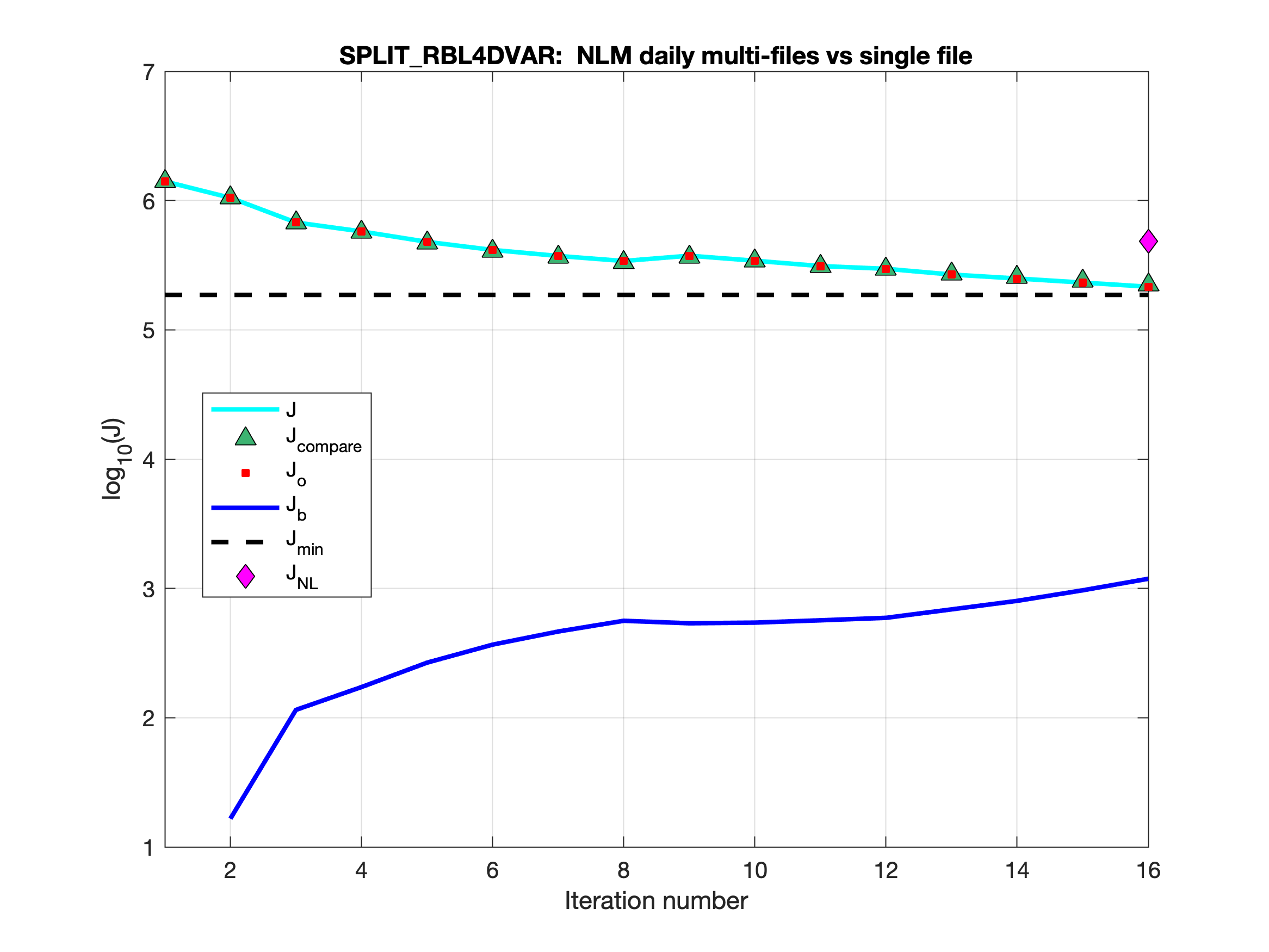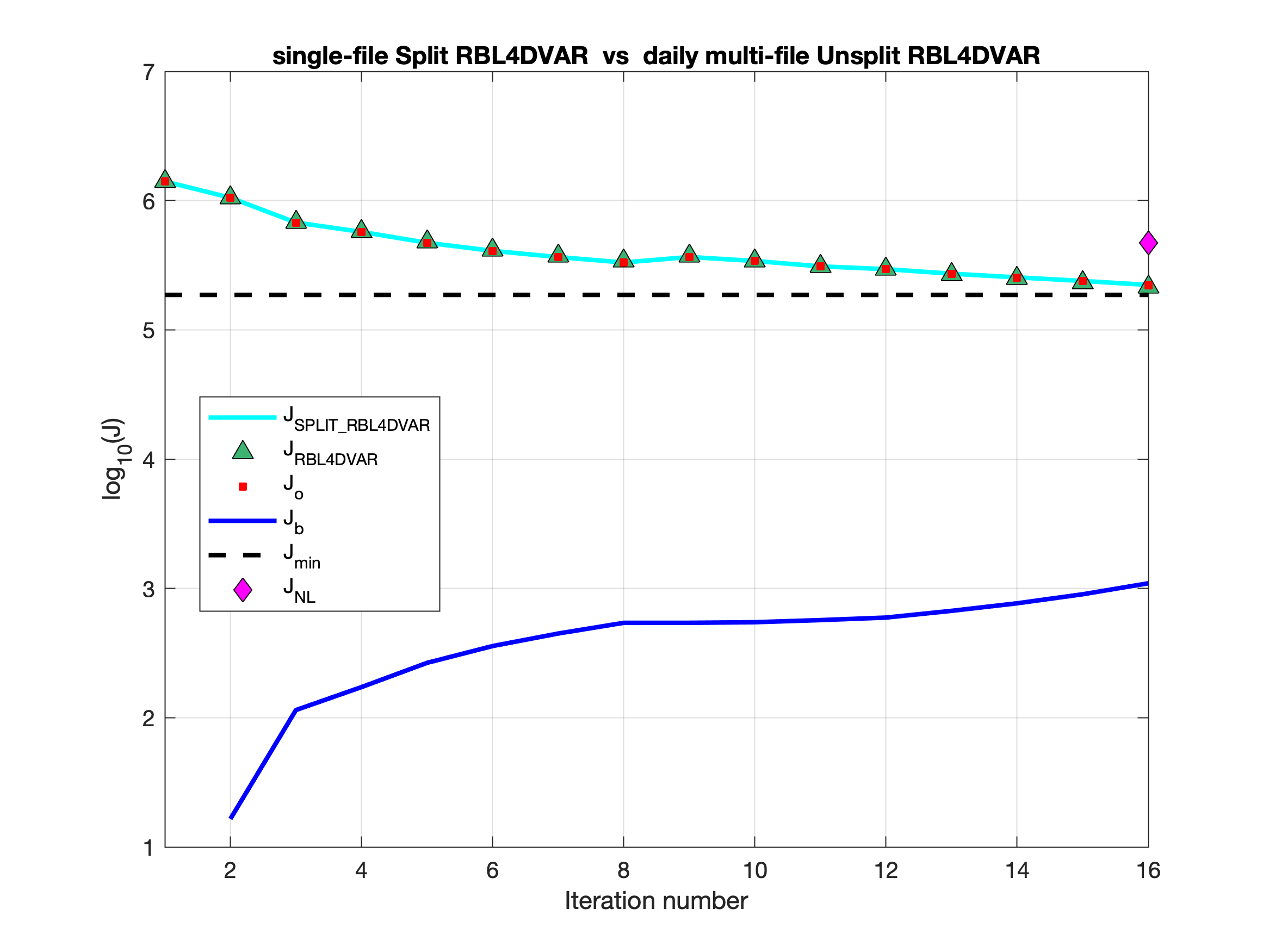| Description |
Testing is completed for the basic split 4D-Var algorithms: I4DVAR_SPLIT, RBL4DVAR_SPLIT, and R4DVAR_SPLIT. Now, we get identical solutions when comparing unsplit and split solutions with the WC13 test case.
The split strategy is scripted to run with different executables in the elementary background, increment, and analysis 4D-Var phases, as mentioned in src:ticket:862. The modules i4dvar.F, rbl4dvar.F, and r4dvar.F have additional code activated with the internal CPP option SPLIT_4DVAR to load values to several variables which are assigned independently in other phases or are in memory in the unsplit algorithm.
- The minimization solvers congrad.F, cgradinet.F, and rpcg_lanczos.F now include routines cg_read_congrad, cg_read_gradient, and cg_read_rpcg, respectively, to read previous outer loop variables from the MODNAME (DAV structure), which will be on memory in the unsplit algorithm. It will come handy when re-starting 4D-Var in the future. This capability is straight forward in the split drivers. Such drivers (split_i4dvar_ocean.h, split_rbl4dvar_ocean.h, and split_r4dvar_ocean.h) will be released in the future.
- The rpcg_lanczos solver is now inside of a module for strong type checking of routine arguments.
- The routine wrt_impulse now reports statistics including the checksum to facilitate comparison of unsplit and split algorithms. For example, we can have:
Converting Convolved Adjoint Trajectory to Impulses: Outer = 001 Inner = 004
WRT_IMPULSE - processing convolved adjoint impulses, records: 1 to 2
file: wc13_roms_tlf_20040103.nc
- zeta
(Rec = 2 Min = -1.30850216E-02 Max = 1.55209772E-02 CheckSum = -1441498552)
- u
(Rec = 2 Min = -5.60027244E+01 Max = 5.89141275E+01 CheckSum = -1370629773)
- v
(Rec = 2 Min = -6.30660677E+01 Max = 8.89201837E+01 CheckSum = -1908057756)
- temp
(Rec = 2 Min = -3.88886922E+01 Max = 1.61558954E+01 CheckSum = -2119489230)
- salt
(Rec = 2 Min = -8.91395412E+02 Max = 3.81362699E+02 CheckSum = 310816551)
- zeta
(Rec = 1 Min = 0.00000000E+00 Max = 0.00000000E+00 CheckSum = 14278099)
- u
(Rec = 1 Min = -1.61792544E+01 Max = 1.64542330E+01 CheckSum = 919474362)
- v
(Rec = 1 Min = -1.44458820E+01 Max = 1.80490759E+01 CheckSum = 661583172)
- temp
(Rec = 1 Min = -2.87144548E+01 Max = 1.04972849E+01 CheckSum = -500278367)
- salt
(Rec = 1 Min = -3.36527609E+02 Max = 3.27248419E+02 CheckSum = -205855439)
- The initial conditions for the next R4DVAR data assimilation cycle is now written in the DAINAME NetCDF file. Here, we use the last record of the representer model (RPM) for the final outer loop instead of the nonlinear model:
DO ng=1,Ngrids
LdefDAI(ng)=.TRUE.
CALL def_dai (ng)
IF (FoundError(exit_flag, NoError, __LINE__, &
& __FILE__)) RETURN
!
WRITE (TLM(ng)%name,10) TRIM(FWD(ng)%head), Nouter
10 FORMAT (a,'_outer',i0,'.nc')
lstr=LEN_TRIM(TLM(ng)%name)
TLM(ng)%base=TLM(ng)%name(1:lstr-3)
IF (TLM(ng)%Nfiles.gt.1) THEN
Nfiles=TLM(ng)%Nfiles
DO ifile=1,Nfiles
WRITE (suffix,"('_',i4.4,'.nc')") ifile
TLM(ng)%files(ifile)=TRIM(TLM(ng)%base)//TRIM(suffix)
END DO
TLM(ng)%name=TRIM(TLM(ng)%files(Nfiles))
ELSE
TLM(ng)%files(1)=TRIM(TLM(ng)%name)
END IF
!
CALL netcdf_get_dim (ng, iRPM, TLM(ng)%name, &
& DimName = 'ocean_time', &
& DimSize = InpRec)
IF (FoundError(exit_flag, NoError, __LINE__, &
& __FILE__)) RETURN
Tindex=1
CALL get_state (ng, iRPM, 1, TLM(ng)%name, InpRec, Tindex)
IF (FoundError(exit_flag, NoError, __LINE__, &
& __FILE__)) RETURN
!
KOUT=Tindex
NOUT=Tindex
CALL wrt_dai (ng, tile)
IF (FoundError(exit_flag, NoError, __LINE__, &
& __FILE__)) RETURN
END DO
Many thanks to Andy Moore for the suggestion.
WARNING: The file varinfo.dat was modified to include metadata for NLmodel_final:
'NLmodel_final' ! Output
'final nonlinear model at observation locations'
'state variable units'
'nulvar'
'datum'
'idNLmf'
'nulvar'
1.0d0
- The nonlinear solution can be split into multi-file in 4D-Var applications to avoid getting huge files. See src:ticket:825 for detailed information. I have been testing this capability for a while and I found out that sometimes the solutions are not bit-by-bit identical. After some testing, I came to the conclusion that the differences are due to roundoff, and the 4D-Var convergence and solution are the same. For example, in our US West Coast DOPPIO application, we get the following cost functions convergence (Nouter=2 and Ninner=8):

The above figure compares two Split RBL4D-Var runs showing the total cost function for the NLM multi-file trajectory case (cyan line) versus the NLM single-file trajectory case (green triangles).

The above figure compares two runs showing the total cost function for Split RBL4D-Var with NLM single-file trajectory (cyan line) versus Unsplit RBLD-Var with multi-file NLM trajectory (green triangles).
Corrected Bug:
Corrected a multi-file bug in output.F, tl_output.F, rp_output.F, and ad_output.F for all ROMS output files in restart applications. For example in output.F, the counter HIS(ng)%load needs reset to zero in restart applications:
IF ((nrrec(ng).ne.0).and.(iic(ng).eq.ntstart(ng))) THEN
IF ((iic(ng)-1).eq.idefHIS(ng)) THEN
HIS(ng)%load=0 ! restart, reset counter
Ldefine=.FALSE. ! finished file, delay
ELSE ! creation of next file
Ldefine=.TRUE.
NewFile=.FALSE. ! unfinished file, inquire
END IF ! content for appending
idefHIS(ng)=idefHIS(ng)+nHIS(ng) ! restart offset
ELSE IF ((iic(ng)-1).eq.idefHIS(ng)) THEN
...
END IF
The same needs to be corrected for the AVG(ng), ADM(ng), QCK(ng), and TLM(ng) structures field load. Many thanks to Julia Levin for bringing this to my attention.
|
| Description |
Several changes are made to support new capabilities that will be released in the future. It is a safeguard for uniformity between official and research repositories.
- mod_scalars.F: Added LreadFRC and LreadQCK switches that will be used in adjoint-based applications when NL_BULK_FLUXES is activated to process basic state, nonlinear surface fluxes from the QCK instead of the FWD (or HIS) NetCDF file. This change is needed for coupled 4D-Var applications.
- cgradient.F: Corrected the reading of the converged Ritz eigenvalues in routine cg_read. We need to have:
!
! Read in converged Ritz eigenvalues.
!
CALL netcdf_get_fvar (ng, model, DAV(ng)%name, &
& 'Ritz', Ritz, &
& ncid = DAV(ng)%ncid, &
& start = (/1/), &
& total = (/Ninner/))
IF (FoundError(exit_flag, NoError, __LINE__, &
& __FILE__)) RETURN
- initial.F: Corrected a shared-memory bug in the scaling of the nesting interpolation weights with the Land/Sea masking. We need to have:
!
!-----------------------------------------------------------------------
! If nesting and Land/Sea masking, scale horizontal interpolation
! weights to account for land contact points.
!-----------------------------------------------------------------------
!
DO ng=1,Ngrids
CALL nesting (ng, iNLM, nmask)
END DO
instead of
!
!-----------------------------------------------------------------------
! If nesting and Land/Sea masking, scale horizontal interpolation
! weights to account for land contact points.
!-----------------------------------------------------------------------
!
DO ng=1,Ngrids
DO tile=first_tile(ng),last_tile(ng),+1
CALL nesting (ng, iNLM, nmask)
END DO
!$OMP BARRIER
END DO
Many thanks to Andy Moore for bringing this to my attention.
- extract_obs.F: A new CPP option ALLOW_BOTTOM_OBS is introduced to avoid rejecting observations (default behavior) in the lower bottom grid cell (k=1). That is, between -h < Zobs < Adepth(:,:,1).
# ifndef ALLOW_BOTTOM_OBS
!
! Reject observations that lie in the lower bottom grid cell (k=1) to
! avoid clustering due shallowing of bathymetry during smoothing and
! coarse level half-thickness (-h < Zobs < Adepth(:,:,1)) in deep
! water.
!
IF ((Zobs(iobs).gt.0.0_r8).and.(Zobs(iobs).le.1.0_r8)) THEN
ObsVetting(iobs)=0.0_r8
END IF
# endif
- edit_multifile.F: Added loading I/O structure QCK into BLK:
!
! Load QCK information into the BLK structure so it can be used to
! process the NLM background surface forcing to be read and processed
! by the TLM, RPM, and ADM kernels.
!
CASE ('QCK2BLK')
IF (ndefQCK(ng).gt.0) THEN
IF (QCK(ng)%ncid.ne.-1) THEN
CALL netcdf_close (ng, iNLM, QCK(ng)%ncid)
END IF
Nfiles=ntimes(ng)/ndefQCK(ng)
IF (nQCK(ng).eq.ndefQCK(ng)) Nfiles=Nfiles+1
CALL edit_file_struct (ng, Nfiles, BLK)
DO ifile=1,Nfiles
BLK(ng)%files(ifile)=TRIM(QCK(ng)%files(ifile))
END DO
BLK(ng)%name=TRIM(BLK(ng)%files(1))
ELSE
BLK(ng)%ncid=-1
BLK(ng)%name=TRIM(QCK(ng)%name)
BLK(ng)%files(1)=TRIM(QCK(ng)%name)
END IF
- stdinp_mod.F: Updated stdinp_unit function to take into account the different standard input script and unit in coupling applications.
!
!-----------------------------------------------------------------------
! Determine ROMS standard input unit.
!-----------------------------------------------------------------------
#ifdef DISTRIBUTE
!
! In distributed-memory configurations, the input physical parameters
! script is opened as a regular file. It is read and processed by all
! parallel nodes. This is to avoid a very complex broadcasting of the
! input parameters to all nodes.
# ifdef MODEL_COUPLING
! However, in ESM coupling, the submission argument is 'coupling.in'
! and the Iname was read and processed in the coupling configuration
! elsewhere.
# endif
!
InpUnit=1
# ifndef MODEL_COUPLING
IF (localPET.eq.0) CALL my_getarg (1, Iname)
CALL mp_bcasts (1, 1, Iname)
# endif
OPEN (InpUnit, FILE=TRIM(Iname), FORM='formatted', STATUS='old', &
& ERR=10)
GotFile=.TRUE.
- nesting.F: Added missing IF-directives in fine2coarse to avoid uncessary exchanges.
|


